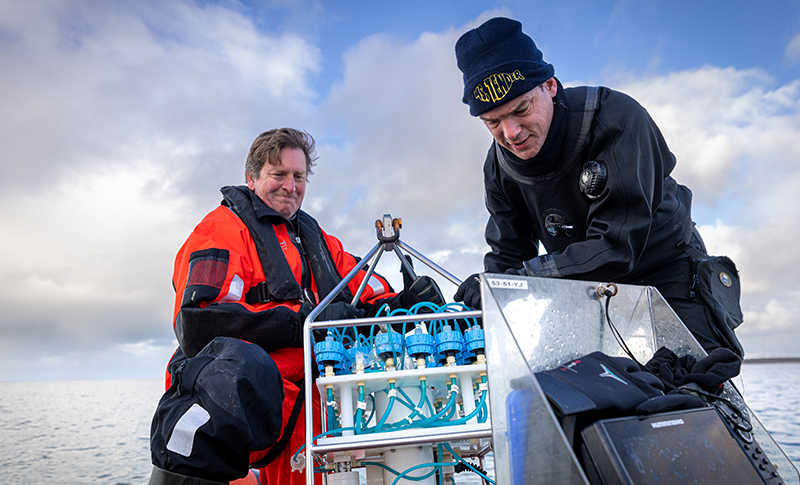Ostensibly simple things like age and sex are difficult to determine in young eels. Wageningen researchers are examining the extent to which methylation patterns – how methyl groups bind to DNA – provide something to go by. And there are more applications on the horizon.
Eels are down as ‘critically endangered’ on the IUCN Red List. Age and sex are important factors for reliably estimating eel stocks, explains Tessa van der Hammen, a researcher at Wageningen Marine Research and a member of the ICES Eel Working Group (WGEEL), which advises the EU on catches. The only problem is that these are tricky factors to pin down, partly because growth patterns can vary greatly depending on where the fish lives. ‘So a particular length is not synonymous with a certain age,’ Van der Hammen explains.
Labels on DNA
The age of an eel is currently estimated by counting the rings on the otoliths, the ear organs found in fish. But this method is expensive, has a relatively big margin of error and involves killing the animals. The planned new method only requires some DNA taken from a small sample of fin tissue. Marine biologist Reindert Nijland: ‘In simple terms, when we analyse methylation patterns, we look at labels on the DNA that determine whether particular genes are expressed or not. At present we have no idea which methylation patterns correlate with which age or sex. But if we can get enough data from enough fish, we can start identifying patterns – using big-data machine-learning algorithms that help us spot the correlations. I am confident that we will succeed in matching patterns to age and sex,’ says Nijland.
Complex sex
DNA from at least 100 eels will be taken for this project, to analyse the methylation pattern and determine their age and sex. For the smaller specimens this is no easy task, explains eel reproduction expert Arjan Palstra. ‘In fish of 30 to 35 centimetres long it’s possible to base sex determination on physical features. But with the smaller fish you can’t do that, or only with great difficulty. Then we have to use methods like measuring hormone levels in the blood to see if we can determine the sex – insofar as that can be distinguished, which is uncertain. That happens with fish: the environment – temperature, pH value, photoperiod, social situation – can affect the phenotypic sex.’
The planned new method only requires a sample of fin tissue to collect DNA
So sex determination is no easy matter, explains Van der Hammen. ‘Only when the young eels have arrived in western Europe is it clear how they are developing: will they be male or female? It depends on the population density: the lower the density, the more females there are. In the Netherlands, the decline of eel stocks is clearly reflected in the sex distribution. You used to find mainly male eels in the IJsselmeer. Now the population there is much smaller and most of the eels are female. The same goes for the Lower Rhine and the North Sea Canal.’
Future research questions
If the methylation method turns out to work well, it will not just offer the advantage of identifying sex and age faster. Researchers also expect to learn a lot about physiology through it. Nijland: ‘If we can trace the locations where the DNA was methylated, we’ll know which genes play a role as well. And although we are now specifically looking for correlations with sex and age, we will sequence everything: the entire DNA of every individual. That data will remain available for answering future research questions.’
Van der Hammen has one important outstanding wish. ‘A very important application would be to determine with methylation patterns whether an eel was released into the wild. Currently a lot of glass eels are released in the Netherlands. Both nationally and internationally, there is quite a debate about whether those released eels can find their way to the Sargasso Sea, and whether they reproduce there as successfully as other eels. We can’t monitor that at the moment: once released, it’s impossible to distinguish a released eel from the rest.’
There are quite a few gaps in our knowledge about eels, says Palstra, particularly concerning what happens in the ocean in relation to reproduction. ‘It was always extraordinarily difficult to develop good research methods for that. These modern techniques seem to herald the dawning of a whole new era of research.’
The project is a collaboration between Wageningen Marine Research and two chair groups: Marine Animal Ecology, and Breeding & Genomics. There are overlaps with both the Centre for Fisheries Research’s statutory research tasks and the Next Level Animal Sciences innovation programme. The work of the next few months will mainly revolve around data collection, and the analysis will follow in 2025. ‘But no doubt we will already do some combing through the data this year. We are extremely curious,’ concludes Nijland.
Measuring methylation
Methylation, the ‘labels’ on DNA, can be measured with a device called a nanopore sequencer, which has been on the market for about five years now. It reads DNA codes at lightning speed by passing single-stranded DNA fragments over a plate with channels – nanopores – that are electrified. The sequence of bases in the DNA can be read because the electrical signal is interrupted when they are in the nanopore. If it contains a methylation group (‘just a C atom with a couple of H atoms,’ says Nijland), you get a different signal than you get if there is no methylation. The software recognizes this automatically. ‘With DNA sequencing, we actually get the information about methylation for free. We just have to apply a different algorithm,’ says Nijland.

 At the Maretarium in Kotka in Finland there is a group of eels known to be 48 years old. Arjan Poelstra snipped a bit of fin tissue from one of the eels to use the DNA as reference material for age determination. Photo Pauline Jehannet
At the Maretarium in Kotka in Finland there is a group of eels known to be 48 years old. Arjan Poelstra snipped a bit of fin tissue from one of the eels to use the DNA as reference material for age determination. Photo Pauline Jehannet 

